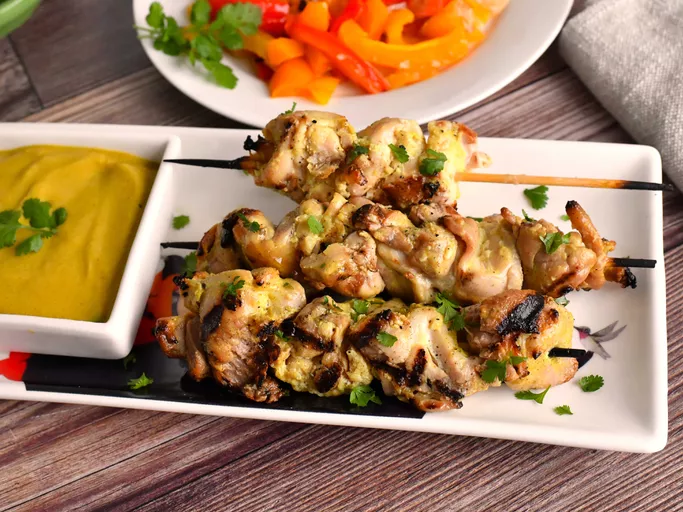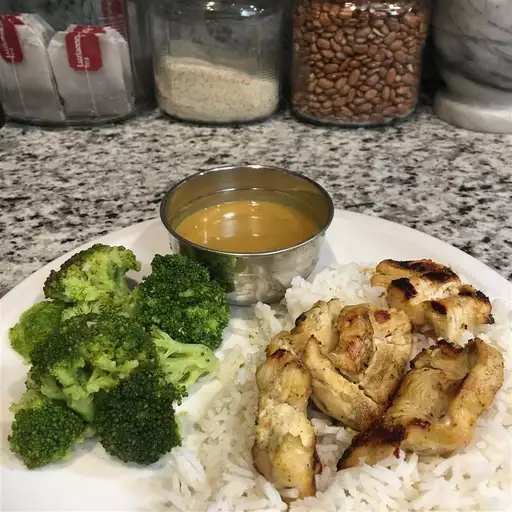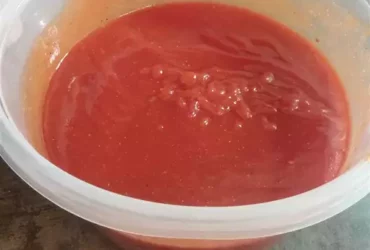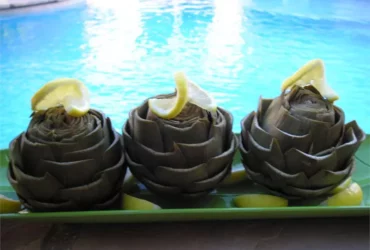Ingredients
Main Ingredients
The main ingredients for making delicious chicken satay can be categorized into several groups: proteins, spices and seasonings, aromatics, and additional ingredients.
The protein component is, of course, chicken breast or thigh meat. For this recipe, you will need boneless, skinless chicken breast or thighs, which should be cut into thin strips or slices about 1-2 inches long and 1/4 inch thick.
The spice blend for the chicken satay typically includes a combination of ground spices such as coriander powder, cumin powder, paprika, and chili powder. You may also need some salt and black pepper to taste.
Aromatics add depth and fragrance to the dish. For this recipe, you can use a combination of minced garlic, grated ginger, and lemongrass paste or chopped lemongrass stalks.
Additional ingredients include coconut milk, which helps to marinate and tenderize the chicken, as well as some oil for cooking the satay. You may also want to serve the dish with a peanut sauce, which typically includes ingredients such as peanut butter, soy sauce, lime juice, and spices like cumin and coriander.
For this recipe, you can use store-bought peanut sauce or make your own using a combination of peanut butter, coconut milk, soy sauce, lime juice, garlic, and spices. You may also want to add some chopped fresh cilantro or scallions for garnish.
Chicken breast or thighs (University of Queensland recommends using highquality meat)
The choice of chicken cut for satay is crucial, and it’s essential to select high-quality meat to ensure the dish turns out flavorful and tender.
According to the University of Queensland, using high-quality meat is recommended, which means opting for fresh and never frozen chicken breast or thighs. Here are some guidelines to help you choose the right cut:
- Chicken Breast: A popular choice for satay, boneless and skinless chicken breasts provide a lean protein source that’s perfect for grilling.
- Chicken Thighs: Rich in flavor and moisture, chicken thighs are an excellent alternative to breast meat. They’re often more affordable and offer a higher fat content, which can help keep the meat juicy during cooking.
When selecting chicken for satay, look for the following characteristics:
- Freshness: Opt for chicken that’s been stored at a low temperature to ensure it remains fresh and safe to eat.
- No additives or preservatives: Choose chicken that hasn’t been injected with added flavorings, antibiotics, or growth hormones.
- High marbling score: If you’re using chicken thighs, look for a high marbling score to ensure the meat is tender and flavorful.
Remember, the quality of your chicken will directly impact the taste and texture of your satay. By selecting high-quality meat, you’ll be well on your way to creating a delicious and authentic Indonesian dish.
Skinless chicken pieces
The first step in making delicious Chicken Satay is to prepare the ingredients, and the star of this dish is undoubtedly Skinless Chicken Pieces. To begin with, you’ll need to select the right cut of chicken for satay. Traditional satay typically uses boneless and skinless chicken thighs or breast pieces, which are easily available at most supermarkets.
The ideal cut should be lean, but not too lean, as it will still retain some moisture when grilled. You can also opt for Organic or Nitrate-Free options if you’re concerned about the quality of your ingredients. It’s essential to choose chicken pieces with minimal fat content to prevent a greasy texture after cooking.
Here’s a list of the required Skinless Chicken Pieces for this Easy Chicken Satay Recipe:
- Boneless, Skinless Chicken Thighs or Breast Pieces
- Pork-Free and Nitrate-Free options for a healthier choice
- Organic or Cage-Free chicken for better flavor and texture
The quantity of chicken pieces you’ll need may vary depending on the number of people you’re serving. As a general guideline, aim for about 1-2 pounds (0.5-1 kg) of skinless chicken per person for this recipe.
Sauce Ingredients
To make a delicious and authentic Creamy Peanut Sauce, also known as “sambal kacang” in Malay, you will need to gather the following ingredients:
The sauce ingredients for this Easy Chicken Satay Recipe are:
- Peanut butter: 1/2 cup creamy peanut butter is the base of our sauce. You can use crunchy or smooth, whichever you prefer.
- Coconut milk: 1/4 cup adds a rich and creamy texture to our sauce. Make sure to get the full-fat version for best results.
- Soy sauce: 2 tablespoons gives our sauce a salty and savory flavor. You can adjust the amount to your taste.
- Honey: 1 tablespoon adds a touch of sweetness to balance out the flavors.
- Lime juice: 1 tablespoon provides a nice acidity and freshness to our sauce.
- Grated ginger: 1 teaspoon adds a spicy and aromatic flavor. You can adjust the amount to your taste.
- Garlic: 1 clove minced, adds a pungent and savory flavor.
- Red pepper flakes (optional): adds an extra kick of heat to our sauce, if you like it spicy. Use sparingly!
Coconut milk (National Institutes of Health suggests using fullfat coconut milk for better flavor)
The success of a delicious Chicken Satay recipe greatly depends on the quality of its key ingredient, coconut milk. A popular dairy substitute in many Asian cuisines, coconut milk plays a crucial role in providing the dish’s distinctive rich and creamy texture.
National Institutes of Health suggest using full-fat coconut milk for better flavor. Full-fat coconut milk contains higher levels of saturated fats, which contribute to its more robust taste and aroma compared to low-fat or skimmed varieties.
The process of preparing high-quality coconut milk begins with selecting the right type of coconut. Young coconut meat is preferred for its creamy texture and mild flavor. To extract coconut milk, shredded coconut is mixed with hot water, then strained through a cheesecloth or fine-mesh sieve to remove any solids.
A well-balanced coconut milk should have the right proportion of fat and liquid content. A general ratio for making homemade coconut milk is 1 part shredded coconut to 2-3 parts water, depending on desired consistency.
The shelf-stable versions of coconut milk available in stores often contain added preservatives or emulsifiers that may affect their flavor and nutritional value. When possible, choose refrigerated or fresh coconut milk to ensure better taste and texture in your Chicken Satay.
Remember to always check the label for any potential allergens or dietary restrictions before using coconut milk in your recipe.
Peanut butter
- The key ingredient that brings flavor and richness to our Easy Chicken Satay Recipe is peanut butter.
- Peanut butter is a thick and creamy paste made from ground peanuts (Arachis hypogaea)
- Peanuts are legumes, which belong to the same family as beans and lentils
- The most common types of peanuts used for making peanut butter include the Virginia and Spanish varieties, each with their unique flavor profiles and textures.
- Peanut butter is an excellent source of protein and healthy fats, containing approximately 8g of protein per tablespoon and 16g of fat per serving.
- It’s also a rich source of vitamins and minerals such as vitamin E, magnesium, and potassium
- The creamy texture of peanut butter adds depth and richness to our Easy Chicken Satay Recipe, balancing out the savory flavors of chicken, soy sauce, and spices.
- To get the best flavor from peanut butter, look for brands that use high-quality peanuts and have minimal added ingredients.
Lime juice
Lime juice is a fundamental ingredient in many Southeast Asian dishes, including the popular Easy Chicken Satay Recipe.
Here are some interesting facts about lime juice:
- There are two main types of limes used for cooking: the key lime and the Tahiti lime. The key lime is smaller and more acidic, while the Tahiti lime is larger and less acidic.
- Lime juice is a natural antibacterial agent and can be used to prevent foodborne illnesses.
- It’s essential for adding brightness and acidity to dishes, making it a great marinade or dressing component.
In the context of Easy Chicken Satay Recipe, lime juice plays a crucial role in enhancing the flavor and tenderness of the chicken.
The acidity in lime juice helps to break down the proteins in the meat, making it more tender and easier to cook.
Additionally, lime juice adds a burst of citrus flavor that complements the sweetness of the peanut sauce perfectly.
To use lime juice effectively in your Easy Chicken Satay Recipe:
- Make sure to squeeze fresh lime juice from real limes and not bottled or packaged lime juice.
- Use a mixture of equal parts lime juice and oil as a marinade for the chicken. Let it sit for at least 30 minutes to an hour before grilling or cooking.
- Add a squeeze of fresh lime juice over the cooked satay for a burst of citrus flavor just before serving.
Soy sauce or tamari
The ingredients used in a traditional or modified recipe for chicken satay often include protein-rich elements like chicken breast, thighs, or a combination of both, which provide the foundation for the dish.
These are typically marinated in a mixture containing aromatics such as shallots, garlic, galangal (a type of ginger), lemongrass, and sometimes fresh Thai chilies, which contribute to the satay’s signature flavor and aroma profile.
The marinade may also incorporate acidic ingredients like lime juice or vinegar to help break down the protein and balance out the flavors.
A key component in many satay recipes is soy sauce or tamari, which serves as a seasoning and helps to intensify the overall umami flavor of the dish. However, it’s worth noting that traditional Southeast Asian cuisine often employs other fermented condiments like patis (fish sauce), kecap manis (sweet soy sauce), or even palm sugar to achieve a rich, savory taste.
The addition of spices and herbs is also common in satay recipes. These can include ground cumin, coriander, cinnamon, nutmeg, cardamom, or various other spices that add depth and warmth to the dish. Fresh cilantro or mint may be used as a garnish, adding freshness and visual appeal.
Some recipes also incorporate coconut milk or yogurt to help tenderize the meat and create a creamy sauce. The type of protein and level of spiciness can vary depending on regional preferences or personal taste.
Here is an example of how these ingredients are typically combined in a satay recipe:
- 2 lbs boneless, skinless chicken breast or thighs
- 1/4 cup soy sauce (or tamari for gluten-free option)
- 2 cloves garlic, minced
- 1 tablespoon grated ginger
- 1 tablespoon brown sugar
- 1 tablespoon vegetable oil
- 2 tablespoons lime juice
- 2 stalks lemongrass, bruised
- 1 Thai red chili pepper, seeded and minced
- Salt and black pepper to taste
- Cilantro or mint for garnish (optional)
This is just one example of the ingredients used in a chicken satay recipe. Feel free to experiment with different combinations of spices, herbs, and condiments to create your own unique flavor profile.
Sugar
Sugar plays a crucial role in cooking, particularly when it comes to balancing flavors in sweet and savory dishes. However, its presence can be quite subtle, especially when used in small quantities or combined with other ingredients. In the context of the Easy Chicken Satay Recipe, sugar is used as an essential component in the marinade.
One common misconception about sugar is that it’s solely reserved for sweet dishes. While this may be true in some cases, sugar serves a multitude of purposes in various recipes. For instance, sugar can help balance out acidity levels, add texture to sauces and marinades, or even enhance the flavors of certain ingredients.
When using sugar in cooking, it’s essential to understand that not all sugars are created equal. There are different types of sugar available, such as granulated sugar, brown sugar, honey, maple syrup, and molasses, each with its unique characteristics and flavor profiles. In the Easy Chicken Satay Recipe, a combination of soy sauce, lime juice, garlic, ginger, and brown sugar creates a well-rounded marinade that enhances the flavors of the chicken.
Brown sugar, in particular, is an excellent choice for sweet and savory dishes due to its deep, rich flavor. Unlike granulated sugar, which can add a harsh or bitter taste if overused, brown sugar contributes a warm, caramel-like sweetness to recipes. This makes it an ideal addition to the Easy Chicken Satay marinade.
The role of sugar in the Easy Chicken Satay Recipe is multifaceted. Not only does it contribute flavor and texture, but it also serves as a tenderizer for the chicken. Sugar can help break down protein bonds, making the meat more susceptible to the acidic properties of lime juice and soy sauce. This results in tender, juicy chicken that’s infused with a sweet and savory glaze.
In conclusion, sugar is an essential ingredient in many recipes, including the Easy Chicken Satay Recipe. By understanding its various purposes and using different types of sugar, cooks can create complex flavors and textures that elevate their dishes to new heights. Whether you’re looking for a subtle sweetness or a bold flavor punch, sugar is an ingredient that deserves attention and experimentation.
Preparation and Cooking
Satay Marinade Preparation
To prepare for making chicken satay, it’s essential to start with a flavorful and aromatic marinade. This marinade not only tenderizes the chicken but also infuses it with Southeast Asian flavors that are characteristic of this popular dish.
Here is a simple recipe for a delicious satay marinade:
Satay Marinade Ingredients:
- 2 cloves of garlic, minced
- 1 tablespoon grated fresh ginger
- 1/2 cup coconut milk
- 1 tablespoon soy sauce
- 1 tablespoon fish sauce (optional)
- 1 teaspoon ground cumin
- 1 teaspoon coriander powder
- 1/4 teaspoon turmeric powder
- 1/4 teaspoon cayenne pepper (or more to taste)
Satay Marinade Instructions:
- In a blender or food processor, combine the garlic, ginger, coconut milk, soy sauce, fish sauce (if using), cumin, coriander powder, turmeric powder, and cayenne pepper. Blend until smooth.
- Transfer the marinade to a bowl and stir in 1/4 cup of vegetable oil or peanut oil.
- Store the marinade in an airtight container in the refrigerator for up to 3 days.
For easy chicken satay, you will need:
- Chicken Breasts: 1 pound boneless, skinless chicken breasts cut into 1-inch pieces
- Satay Marinade (previously prepared)
- Pineapple and Onion Slices: 1 cup pineapple chunks and 1 cup red onion slices for serving
To cook the chicken satay, follow these steps:
- Preheat a grill or grill pan to medium-high heat.
- Grill the satay for 8-10 minutes on each side, or until the chicken is cooked through and slightly charred.
Serve the chicken satay hot with your favorite peanut sauce (such as Indonesian kecap manis) and a sprinkle of toasted peanuts and fresh cilantro. Enjoy!
Mix peanut butter, lime juice, soy sauce, sugar in a blender until smooth
To prepare and cook delicious chicken satay, you’ll need to start with some basic ingredients and follow a simple cooking process.
Here are the ingredients you’ll need:
- 500g boneless, skinless chicken breast or thighs
- 1/2 cup peanut butter
- 2 tablespoons lime juice
- 2 tablespoons soy sauce
- 1 tablespoon sugar
- 1 teaspoon grated ginger
- 1 clove garlic, minced
- 20 bamboo skewers, soaked in water for at least 30 minutes
- Vegetables such as onions, bell peppers, and mushrooms for serving (optional)
Now, let’s move on to the preparation and cooking process.
Step 1: Prepare the marinade
- In a blender or food processor, combine the peanut butter, lime juice, soy sauce, sugar, ginger, and garlic. Blend until smooth and creamy.
- This will be your marinade for the chicken.
Step 2: Thread the chicken onto skewers
- Remove the chicken from the refrigerator and thread each piece onto a bamboo skewer, leaving a small space between each piece.
Step 3: Brush with marinade and grill or broil
- Brush the chicken with the peanut butter marinade, making sure each piece is coated evenly.
- Grill or broil the satay for 5-7 minutes per side, or until cooked through and slightly charred.
Step 4: Serve
- Serve the chicken hot with your favorite sides, such as rice, noodles, or vegetables. You can also serve it with peanut sauce, kecap manis (sweet soy sauce), or other dipping sauces of your choice.
- This is a simple and delicious recipe for chicken satay that’s sure to please even the pickiest eaters!
Add coconut milk and blend until well combined
To make a delicious Chicken Satay, you’ll need to focus on preparation and cooking techniques that will elevate this Southeast Asian dish.
Preparation
The first step in preparing your chicken for satay is to marinate it. You can do this by mixing together some coconut milk, soy sauce, brown sugar, garlic paste, grated ginger, and a pinch of salt. Make sure to mix everything well so that the marinade coats all the chicken evenly.
Next, take your chicken breast or thighs and cut them into thin strips. This will help them cook evenly and quickly when you grill them later on.
Now it’s time to add some aromatics to give your satay its distinctive flavor. You can do this by sautéing some onions, garlic, and lemongrass in a pan until they’re softened. Then, add the coconut milk and bring the mixture to a simmer.
Once the marinade has thickened and reduced slightly, you can add it to your chicken and mix everything together. Cover the bowl with plastic wrap and refrigerate for at least 2 hours or overnight to allow the flavors to meld together.
Cooking
To cook your chicken satay, you’ll need a grill or grill pan. If you’re using a grill pan, make sure it’s hot before adding the chicken. You can test the heat by flicking a few drops of water onto the pan – if they sizzle and evaporate quickly, the pan is ready to go.
Thread the marinated chicken strips onto skewers, leaving a small space between each piece. Brush the grill or grill pan with some oil to prevent the chicken from sticking.
Once your grill or grill pan is hot, add the chicken satay and cook for 5-7 minutes on each side, or until they’re cooked through and slightly charred.
To serve, garnish your satay with some sliced cucumbers, tomatoes, and onions. You can also serve it with a side of peanut sauce or kecap manis (sweet soy sauce) for added flavor.
Tips and Variations
Bullet points:
- Peanut free options: If you’re allergic to peanuts, you can substitute them with almond or cashew butter in the satay sauce.
- Grill vs. grill pan: You can also cook your chicken satay on a gas or charcoal grill for a smoky flavor.
- Marinade time: You can marinate your chicken for up to 24 hours for even more intense flavors.
- Satay sauce: You can also serve your satay with store-bought or homemade satay sauce for added flavor.
Transfer the marinade to a bowl and add chicken pieces
To begin preparing the Easy Chicken Satay Recipe, it’s essential to focus on two critical components: preparation and cooking.
Preparation involves several steps that ensure your dish turns out flavorful and visually appealing. Start by preparing the marinade for the chicken, which typically consists of ingredients such as coconut milk, soy sauce, brown sugar, garlic, ginger, coriander powder, cumin powder, salt, and black pepper.
The next step in preparation is to combine these marinade ingredients in a bowl. This allows you to ensure that all the flavors are well mixed together.
Once your marinade is ready, transfer it to a large enough bowl to hold the chicken pieces without overcrowding them. The ideal ratio of chicken to marinade is usually about 1:2, meaning for every pound of chicken, use two pounds of marinade. This ensures that all parts of the chicken are fully coated with the flavors.
Now, carefully add the chicken pieces (sliced or cut into bite-sized portions) to the bowl with the marinade. It’s crucial to ensure each piece is evenly coated with the marinade by gently tossing the mixture together using your hands or a spatula.
To guarantee that your chicken absorbs the flavors well, it’s recommended to marinate for at least two hours, but ideally overnight (about eight hours) in the refrigerator. This prolonged exposure helps break down the proteins and infuse deep, rich flavors into the meat.
Serving and Tips
Grilling and Serving
Serving and tips for grilling and serving chicken satay are essential to ensure a delightful dining experience for you and your guests.
First, let’s start with serving suggestions. Traditionally, chicken satay is served as an appetizer or snack, often accompanied by peanut sauce for dipping.
You can serve it at room temperature or slightly warmed, depending on your preference. If you’re planning a gathering or party, consider setting up a skewer bar with various sauces and toppings for guests to customize their own satay.
Another popular way to serve chicken satay is as part of an Asian-inspired buffet or platter, paired with other dishes like spring rolls, edamame, or nasi goreng.
Tips for grilling and serving chicken satay include:
Marinating the chicken for at least 30 minutes to an hour will help ensure tender and flavorful meat. You can marinate it in a mixture of coconut milk, lime juice, soy sauce, brown sugar, garlic, and ginger.
Preparing the peanut sauce ahead of time will save you from last-minute stress. Simply combine peanut butter, coconut milk, lime juice, fish sauce (optional), brown sugar, and chili flakes in a blender or food processor until smooth.
Grilling the chicken over medium-high heat for about 5-7 minutes per side will give it a nice char and caramelized flavor. Be sure to rotate the skewers every minute or two to ensure even cooking.
Let the chicken rest for a few minutes before serving, allowing the juices to redistribute. This will help keep the meat moist and juicy.
For a more authentic experience, consider setting up a satay station with all the fixings, including peanut sauce, kecap manis (sweet soy sauce), chili flakes, chopped cilantro or scallions, and toasted peanuts or cashews.
This way, guests can assemble their own skewers to their liking, adding a personal touch to each dish. With these serving tips and grilling guidelines, you’ll be well on your way to hosting a memorable and delicious satay experience for yourself and your loved ones.
Thread chicken pieces onto skewers
To serve and enjoy this delicious chicken satay, follow these steps:
Thread chicken pieces onto skewers: This step may seem simple, but it requires a bit of finesse to ensure that the chicken is evenly spaced and secure on the skewer.
Here’s how to thread chicken pieces onto skewers like a pro:
- Start by holding the skewer vertically with one hand. This will help prevent the chicken from falling off as you thread it.
- Take a few pieces of chicken and place them on top of each other, aligning them in a straight line. This will ensure that they cook evenly.
- Hold the chicken pieces together with one hand, and use your other hand to thread the skewer through the center of the meat. Make sure the skewer goes all the way through, securing the chicken in place.
- Repeat this process for each piece of chicken, spacing them evenly apart on the skewer. This will help prevent overcrowding and ensure that the chicken cooks properly.
Tips:
- Use a variety of colors: Thread the chicken onto skewers in different colors to make them more visually appealing.
- Alternate with vegetables: Alternate the chicken with vegetables such as onions, bell peppers, and mushrooms to add flavor and texture.
- Don’t overcrowd: Leave enough space between each piece of chicken to allow for even cooking and to prevent overcrowding.
By following these steps and tips, you’ll be able to create delicious and visually appealing chicken satay that’s sure to impress your friends and family!
Preheat grill or grill pan and brush with oil
To start serving and enjoying your delicious chicken satay, you’ll want to ensure that you have a few essential tools on hand. A grill or grill pan is necessary for cooking the satay to perfection, and it’s also important to brush the grates with oil before adding the chicken skewers. This will help prevent the chicken from sticking to the grill and make it easier to flip them during cooking.
When preheating your grill or grill pan, be sure to set it to a medium-high heat setting. This will allow you to achieve the nice char marks on the outside of the chicken while still keeping the inside juicy and tender. If you’re using a gas grill, you can usually adjust the heat setting by turning one or more of the dials on the control panel.
Once your grill is preheated, it’s time to brush it with oil. You’ll want to use a high-heat cooking oil, such as peanut oil or vegetable oil, and apply a thin layer to the grates using a paper towel. This will help prevent the chicken from sticking to the grill and make it easier to flip them during cooking.
After brushing the grill with oil, you can start adding your chicken skewers to the grill. Place the skewers on the grill at an angle so that they’re not directly over any of the heat sources, and cook for 2-3 minutes per side or until the chicken is cooked through and slightly charred.
Remember to always use a food thermometer to check the internal temperature of the chicken. It’s especially important when cooking meat to an internal temperature that’s safe for consumption. For satay, you’ll want to cook the chicken to an internal temperature of at least 165°F (74°C).
Once your chicken is cooked, remove it from the grill and let it rest for a few minutes before serving. This will allow the juices to redistribute throughout the meat, making it even more tender and flavorful.
When serving your satay, consider setting up a platter or tray with all of the fixings. You can include peanut sauce, sliced cucumbers, cherry tomatoes, and chopped cilantro for a fresh and flavorful garnish. Don’t forget to serve some warm rice or naan bread on the side to help soak up any of the delicious juices.
Cook for 57 minutes per side, or until cooked through
When serving chicken satay, it’s essential to consider a few key factors to ensure that your dish looks and tastes its best.
Tips for Serving
Here are some helpful tips for serving your delicious chicken satay:
- Provide a variety of dipping sauces: Serve your chicken satay with a selection of sauces, such as peanut sauce, kecap manis (sweet soy sauce), and sambal oelek (chili paste). This will allow your guests to customize their experience.
- Add some crunch: Offer a side of toasted peanuts or crispy fried shallots to add texture and interest to the dish.
- Garnish with fresh herbs: Sprinkle some chopped cilantro, basil, or mint leaves on top of the chicken satay for added color and fragrance.
Cooking Time
When cooking your chicken satay, make sure to cook it evenly. A good rule of thumb is to cook each side for at least 57 minutes, or until cooked through. However, the exact cooking time may vary depending on the thickness of your skewers and the heat of your grill.
How to Check if Chicken Satay is Cooked
To check if your chicken satay is cooked, follow these steps:
- Insert a food thermometer into one of the chicken pieces. The internal temperature should reach at least 165°F (74°C).
- Check for doneness by cutting into one of the pieces. The chicken should be opaque and firm to the touch, with no pink or raw meat visible.
Grilling Tips
Here are some additional tips for grilling your chicken satay:
- Preheat your grill to medium-high heat (about 400°F/200°C).
- Brush the skewers with oil before placing them on the grill.
- Turn the skewers frequently to ensure even cooking and prevent burning.
Safety First
When handling raw meat, it’s essential to prioritize food safety. Make sure to wash your hands thoroughly before and after handling the chicken, and always cook the satay to an internal temperature of at least 165°F (74°C).
Serve hot with sauce (such as peanut sauce) on the side
Serving suggestions can elevate the dining experience for guests, and serving chicken satay hot with a variety of sauces is an excellent way to cater to different tastes.
For those who prefer their meal plain, you can serve the chicken satay without any sauce, allowing each guest to season as they see fit. However, this is less likely to be a common request, and most people appreciate having multiple options available.
One of the most popular choices for serving with chicken satay is peanut sauce – it adds an earthy flavor complemented by creamy texture that pairs perfectly with grilled poultry or pork.
The other commonly served option would be kecap manis which is a sweet soy sauce, although not as thick and rich in flavor compared to the peanut sauce.
It’s worth noting that these sauces are traditionally used as accompaniments to allow guests to control how much of each they prefer on their individual portions rather than covering up any flavors from your satay itself.
To prepare for serving, it’s helpful if you have a platter or board with different components – the satay itself arranged neatly alongside bowls containing sauces.
This will make it clear what’s being offered without overwhelming guests with too many options all at once. Be sure also to provide some garnishes such as fresh herbs like mint leaves, chili slices for added heat or lime wedges which contribute freshness.
By presenting your dish in an inviting and visually appealing way, you’ll set a positive tone for everyone who gathers around the table together enjoying good food with great company!
- Best Lusha Alternatives for 2025 - April 22, 2025
- Best Overloop Alternatives for 2025 - April 22, 2025
- Best 6sense Alternatives for 2025 - April 22, 2025















